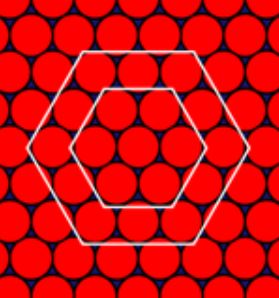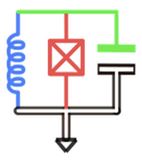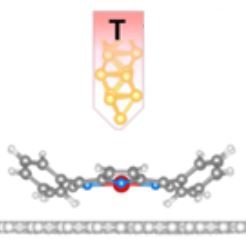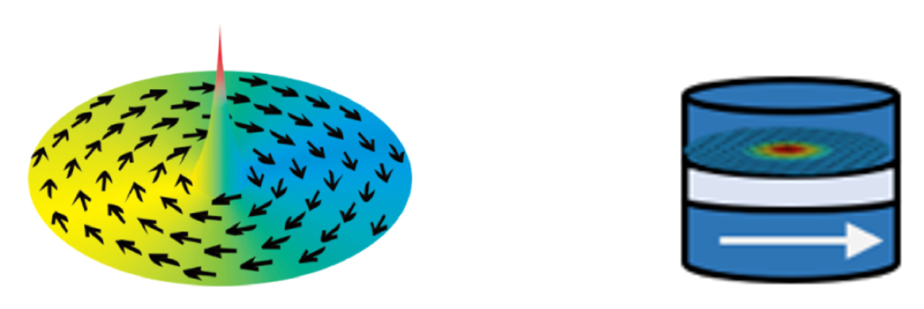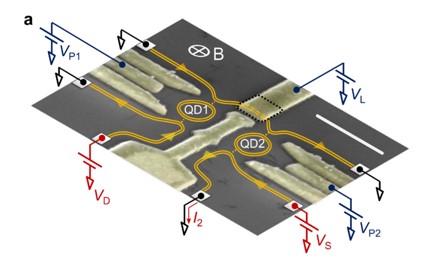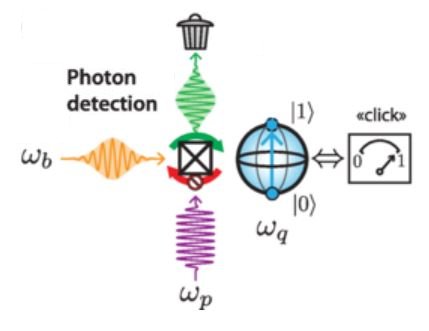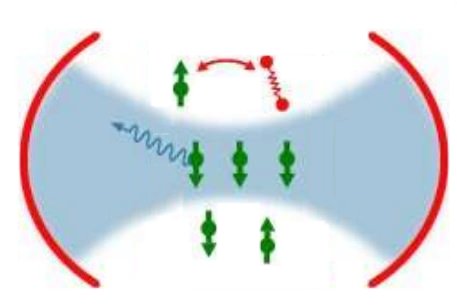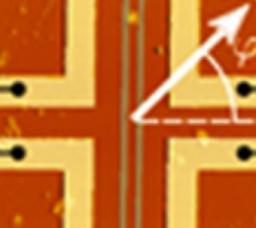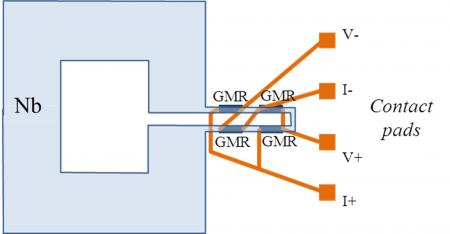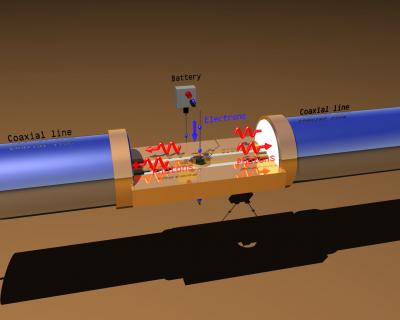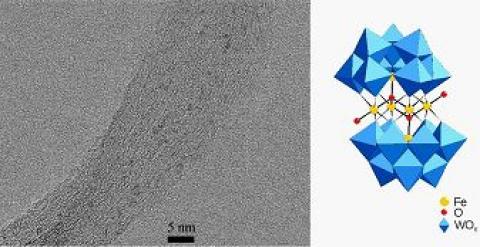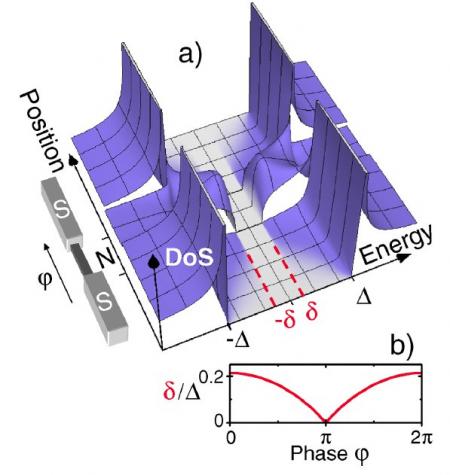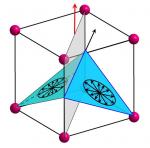Feb 02, 2024
Active particles can form two-dimensional crystals that are different from those formed by passive particles in equilibrium, showing extreme spontaneous deformation at large scales without melting.
Jan 24, 2024
Une collaboration de physiciens a réalisé un nouveau type de bit quantique supraconducteur à basse fréquence (MHz au lieu du GHz) dont la sensibilité aux charges électriques est à même de permettre le contrôle et la mesure de l’état quantique d’un micro-résonateur mécanique.
Jul 11, 2022
Version française.
Knowing how to manipulate at the nanometric scale, a single spin, as an object carrying quantum information, presents a major technological challenge, and still remains a subject of great fundamental interest.
May 17, 2021
Magnetic sensors based on the displacement of a vortex core in a magnetic tunnel junction are currently proposed to obtain linear field responses over a large range (typically a few tens of mT) while keeping a very good sensitivity for various applications (automotive, biomedical). However, these sensors present a very important low frequency magnetic noise which limits their detection performance.
Nov 18, 2020
Researchers from SPEC (in collaboration with the C2N and the University of Genoa) have observed the fading and partial reappearance of an electron injected at a finite energy into chiral one dimensional electronic channels propagating along the edges of a two dimensional electron system. These results will help elucidating to which extent these electrons can be used to implement the electronic analogues of quantum information experiments done with photons.
Oct 16, 2020
Graphene is a two dimensional, material made of a carbon atomic plane, with exceptional physical properties that make it full of promises for applications in various fields. The realization of new functionalities for advanced devices is highly desirable and can be achieved by modifying the structure or chemical composition of graphene.
Jun 01, 2020
La détection de photons uniques est un élément clé dans le développement des technologies quantiques, où le signal résultant d'un calcul quantique peut se limiter à l'émission d'un seul photon.
May 23, 2020
Au sein d'un échantillon solide, réduire la température des spins est une bonne méthode pour améliorer le signal de RMN ou de RPE, puisque cela favorise leur polarisation selon la direction imposée par le champ externe appliqué.
Jul 11, 2019
La métrologie (spectroscopie, mesures de temps ou de distances) ou encore la réalisation de réseaux optiques quantiques nécessitent des sources de photons uniques efficaces. Une équipe du SPEC à Saclay, en collaboration avec l'IQST d'Ulm en Allemagne, propose une voie originale pour obtenir une source de photons microondes uniques, simple, efficace et brillante.
Mar 11, 2019
La métrologie (spectroscopie, mesures de temps ou de distances) ou encore la réalisation de réseaux optiques quantiques nécessitent des sources de photons uniques efficaces. Une équipe du SPEC à Saclay, en collaboration avec l'IQST d'Ulm en Allemagne, démontre expérimentalement une voie originale pour obtenir une source de photons microonde uniques, simple, efficace et brillante.
Jul 30, 2018
Pure spin conductors could behave as nonlinear component in the high power regime, hereby opening up considerably the realm of functions realizable with magnetic materials. An additional feature is that these are continuously tunable by an external magnetic field.
Jan 23, 2018
La résonance magnétique a un impact important dans nos vies de tous les jours, de l’imagerie médicale au contrôle qualité dans la production de bière. Cette technique utilise de puissants aimants et des impulsions radio-fréquence ou micro-ondes pour révéler de faibles concentrations de molécules dans une substance.
Jan 23, 2017
An international team published in Nature, the discovery and interpretation of a surprising form of biological collective motion: They observed that millions of motile cells in dense bacterial suspensions can self-organize into highly robust collective oscillatory motion, while individuals move in an erratic manner.
Jun 01, 2016
Les verres forment l’essentiel de nos matériaux du quotidien, et prennent une place croissante dans les technologies modernes (fibres optiques, etc…).
Nov 23, 2011
K. Katsuyoshi, D. L'Hôte, S. Nakamae, M. Konczykowski, V. Mosser
Le théorème de fluctuation-dissipation, reliant l'intensité des fluctuations d'une observable à la réponse à une sollicitation, est un principe vérifié pour tous les systèmes à l'équilibre thermodynamique.
Jul 18, 2011
( Version française)
Stress corrosion - combined action of mechanical stress and corrosion by water from the surrounding atmosphere - is often the cause of crack propagation in glasses. A study by neutron reflectivity at the Laboratoire Léon Brillouin (IRAMIS / LLB) of samples of silica glass fractured under an atmosphere of heavy water (D2O) shows a high penetration of water into the glass.
Apr 19, 2011
Measurement of the cardiac electrical activity allows following the heart dynamics. Usually measured with electrodes during an electrocardiogram (ECG), this activity can also be studied by monitoring the magnetic component, induced by the circulation of the heart electric currents. This is called "magnetocardiography (MCG).
Sep 16, 2010
Eva Zakka-Bajjani, J. Dufouleur, N. Coulombel, P. Roche, D. C. Glattli, and F. Portier
( French version)
Contact: Dr. Fabien PORTIER
A conductor in equilibrium under a bias voltage shows current fluctuations proportional to its resistance and temperature. This type of noise is known as the Johnson-Nyquist noise, or equivalently, the thermal noise. In a quantum conductor, current fluctuations generate microwave photons which obey chaotic statistics (cf., blackbody radiation) if the conductor is at equilibrium.
Apr 14, 2010
Benjamin Pigeau, Grégoire de Loubens, and Olivier Klein: Groupe Nanomagnétisme
In a vortex-state magnetic nanodisk, the static magnetization is curling in the plane, except in the disk center where it is pointing out-of-plane, either up (polarity p=+1) or down (p=-1). The lowest energy excitation mode of this ground state is the so-called gyrotropic mode [1], corresponding to a gyration of the vortex core around its equilibrium position at the center of the disk.
Mar 30, 2010
( Version française)
Researchers in the Instability and Turbulence Group of IRAMIS-SPEC have succeeded in experimentally characterizing the non linear mechanical response of an amorphous granular media across the jamming transition. They have demonstrated that global rigidity sets in via the critical growth of a correlation length.
Mar 16, 2010
Depending on their fracture mode, materials are traditionally gathered into three distinct classes:
(i) ductile materials that like metals deform plastically before their fracture
(ii) quasi-brittle materials such as rock or concrete, where "non-visible" damage starts to accumulate through microcracking, up to coalescence that yields to catastrophic failure.
(iii) brittle materials like oxide or polymer glasses... that deform elastically up to their fracture.
Nov 26, 2009
H. Cao, A. Gukasov, I. Mirebeau, P. Bonville, C. Decorse, and G. Dhalenne
In geometrically frustrated magnetic compounds, the ground state is the result of a subtle equilibrium between different energy terms. Exotic short range magnetic orders, like spin ices or spin liquids, may be stabilised, in the absence of any chemical disorder. Presently, many experimental and theoretical works are devoted to their understanding.
A crystal lattice where frustration plays an important role is the pyrochlore lattice.
Nov 17, 2009
Making still smaller and less power consuming digital memories for mobile electronics? Scientists from CNRS and University Paris Sud XI (Laboratory of Solid State Physics, CNRS / Univ. Paris-Sud 11 and Institut Néel) and CEA-IRAMIS come to demonstrate the feasibility, thanks to a new class, said multiferroic, of materials combining unusual electrical and magnetic properties.
This text is a translation of the joint press release from CEA-CNRS-Univ.
Oct 13, 2009
Iouri Mukharsky, Andrei Penzev and Eric Varoquaux, Nanoeletronics group
If it truly does exist, a "supersolid" would represent a new state of matter that combines mechanical rigidity and superfluid properties. This would be a new phase of condensed matter, but whether such a state has indeed been discovered and how it can be reached is still far from clear. As reported in Physical Review B 80 (2009) 140504(R), researchers at SPEC have measured the low frequency elastic properties of solid helium-4 using ultra-sensitive acoustic techniques.
Sep 30, 2009
F. Mallet, F. Ong, A. Palacios, F. Nguyen, P. Bertet, Denis Vion and D. Esteve
After the realization in 2002 of one of the first solid state quantum bits (qubits), scientists from the Quantronique IRAMIS-SPEC research group have performed a further step towards the realization of an elementary quantum processor: the accurate and non destructive readout of such a qubit.
Jun 25, 2009
Single molecule magnets grafted on carbon nanotubes : the first of its kind has been realized at the Molecular Chemistry and Materials Institute in Orsay (CNRS/University of Paris 11) in collaboration with the Institut Lavoisier de Versailles (CNRS/Université de Versailles Saint-Quentin), the Laboratoire de Chimie Physique (CNRS/Université Paris 11), the Molecular Electronics Laboratory (CEA-Saclay/SPEC) and the Néel Institut in Grenoble (CNRS/Université Joseph Fourier).
Jun 09, 2009
( Version française)
We thought we knew transistor physics fairly well and in particular the millions of MOSFETs (Metal Oxyde Semi-conducteur Field Effect Transistor) which can be found at the core of our computers. However, as early as 1994, a new generation of very high mobility MOSFETs lead to experiments where one could study the regime of extremely low density (Kravchenko et al 1994).
Dec 19, 2008
H. le Sueur, P. Joyez, H. Pothier, C. Urbina, and D. Esteve
The Editors of the journal Physical Review Letters recently awarded the label "Editor's suggestion" to an article from the Quantronics group of SPEC (Laboratory of Condensed Matter Physics) : "Phase Controlled Superconducting Proximity Effect Probed by Tunneling Spectroscopy, Phys. Rev. Lett. 100 (2008) 197002".
Jul 15, 2008
D. Bonamy and L. Ponson (SPCSI), D. Santucci (Fysik Institutt Oslo)
Fracture is a phenomenon of everyday life: it is observable at all scales of condensed matter, from the atomic scale (in nanostructures) to the scale of our planet marked by fractures in the continental plates. But, can we find a unifying model to describe the phenomenon?
The dynamics of fracture is complex.
Apr 16, 2008
Delphine Lebeugle, Dorothée Colson, Anne Forget, Michel Viret (IRAMIS/SPEC CEA-Saclay) Arsen Goukassov, Alexandre Bataille (IRAMIS/LLB CEA-Saclay)
Magnetic materials are heavily used in the dynamic storage of information (hard disk drive, head for reading). For these applications, they are most often designed in the form of thin films. This was achieved after the birth of the spin electronics or "spintronics" and the discovery of the giant magnetoresistance.









